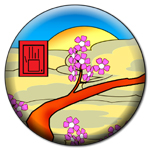On The Way: The Daily Zen Journal
The Four Great Barriers
Sheng-yen (1930-2009)

At some point, after diligent practice, you begin to experience things beyond the simple tranquility that came easily in the early stages. You should know that the path that lies ahead is the same path traveled by the Buddhas and bodhisattvas, and therefore presents unlimited potential for liberation.
Though you may feel at any stage that your achievement is genuine, each attainment is also a barrier and can be an obstruction to further progress. But each barrier is also an opportunity to progress to the next stage.
For the meditator who is on the path of liberation, there are four great barriers to pass. When I speak of barriers I do not refer to something absolute. Everyone’s experience will be unique.
At any given time, people are at different stages according to their karma, potential, and effort. I will describe these barriers so you will recognize them, and you will be aware that there can be problems, even at high levels of attainment.
The first barrier is the experience of limitless light and sound. The second is the state of extreme peace and purity. The third is attaining emptiness, enlightenment. The fourth and ultimate barrier is shattering emptiness itself.
The first barrier arises from samadhi, or deep concentration, and comes as an experience of boundless bright light and sounds of music, beyond description, endlessly floating. You feel very clear and very relaxed. You are not beyond time and space, for light exists in space, and music plays in time.
But this light and sound seem limitless, and you feel liberated. As long as you are meditating there is no problem. But when you return to the everyday world you also return to its influence and distractions. You return to attachments. You find that you cannot maintain that state for long.
As your practice strengthens and your samadhi deepens, you may enter the second barrier, a sense of extreme purity and peace. You feel as if you are beyond time and space, as if they didn’t exist.
In that state, a whole day or night could pass in a flash. Many people who enter this state think that they have become enlightened. With even stronger practice, as you work through the second barrier, coming out of samadhi, your mind is pure and peaceful.
Vexations don’t arise easily. But rarely can this condition be maintained for more than two weeks. After a while, it will begin to fade. This is not to say that every time you sit you can say, “Now I will go into samadhi,” and just do it.

Both of these stages can easily be mistaken for genuine enlightenment, but, in fact, they are not because there is still attachment. In the first stage, there is attachment to the limitless light and sound. At the second stage, there is attachment to the feeling of purity and peace. Since you have attachment, it is very difficult to recapture the experience at will. The only thing you can do is to forget about it and start from the very beginning.
On a previous retreat, I described the stages of emptiness in meditation, and how one goes step by step into a deeper state of meditation. The same applies here. It would be impossible to go from the mind of attachment directly to a deep meditative state.
You have to start from a shallow meditation and then go progressively deeper and deeper. As you go into these deeper levels, your mind gradually becomes purer, until you reach the point where you are no longer attached. In other words, with proper application of method and technique, even with deep attachment, you can enter these realms of delight.
If you don’t have a good master to guide you at this point, there are two problems. First, you try to regain the state you once achieved. This is an obstruction to further practice. Second, if you don’t have the guidance of a good master, you may assume you’ve reached the highest stage.
You want to believe that you have reached the ultimate, but in daily life vexations and attachments return, and you will experience doubt. “Did I really get enlightened?”

After tossing the question around, you may conclude, “Yes, I probably did reach the highest state. Maybe even the great masters didn’t go beyond this.” Because you have doubt, you try to convince yourself you are at the level of the masters. If you do this, you have given rise to a kind of pride that is hard to uproot.
If you get past the first two barriers, and find yourself approaching the third, you may be on the threshold of genuine enlightenment. But, unlike the first two stages, there are no words for enlightenment.
Enlightened people see the world just as it is. Indeed what they see is completely different from what the ordinary person perceives. When they see a leaf they may see the cosmos contained in it.
This is neither psychic power nor normal knowledge. If you ask them to talk about it they can say nothing. They would feel neither delight nor aversion. It’s just a state of great awakening.

Usually, when people reach this stage, they feel they have attained the ultimate, that they have been liberated, like the Buddha, from the cycle of birth and death. It is very good to reach this stage. But if you stop here, there will still be a thought in your mind.
That thought is the idea of enlightenment itself, the feeling that you have had the great awakening. You are dwelling in emptiness, and you miss the point.
To get beyond this barrier, we have to go to the fourth and ultimate barrier shattering emptiness itself. In the state of emptiness, one feels that everything exists without obstruction. That is the meaning of emptiness.
The meaning of shattering emptiness is dissolving even the enlightened state. You give up the feeling that you’ve had the great awakening. You will feel ordinary again. Only then will you sleep the dreamless sleep, only then will you be truly liberated.
According to the course of progress of Hinayana Buddhism, you have tasted the fruit of the arhat stage. But you still must continue practicing because you still may fall back. You may think, “How can we all do this? It sounds so remote.”

On the other hand, if I were to tell you that passing the first barrier amounts to great liberation, I would be deceiving you. If you have any doubts, practice hard, and let your doubts grow to the size of a mountain. Remember: small doubt leads to small awakening; great doubt leads to great awakening.
Sheng-yen (1930-2009)
Excerpted from Getting the Buddha Mind – On the Practice of Chan Retreat 1982





In ancient times not much was revealed about what the enlightenment experience consisted of. And since Zen is a teaching outside of words and letters, many were left to just sit.
Terse were the responses to many questions leaving most to remain in the dark. There were many who experienced siddhis in Yoga practice, but these were not a part of Zen.
This is a surprising talk by Sheng-yen during a retreat that indicated some of the students were getting confused and a bit attached to transient states. However, this is still something that happens to many who meditate wanting to know where they are in practice. Similar to children on a long car trip asking, “Are we there yet?”
Great effort, no goal – this is a phrase we heard in practice. The key here is to have no stopping place. All experience is transient. As tantalizing as some spiritual states can seem, they are just another kind of spiritual materialism.
However you word it to yourself, the safety net in practice is more practice. And for those with no teacher, fashioning a practice for life can take many forms. Best not to get stuck anywhere and question yourself at each crossroad.
Letting go,
Elana, Scribe for Daily Zen